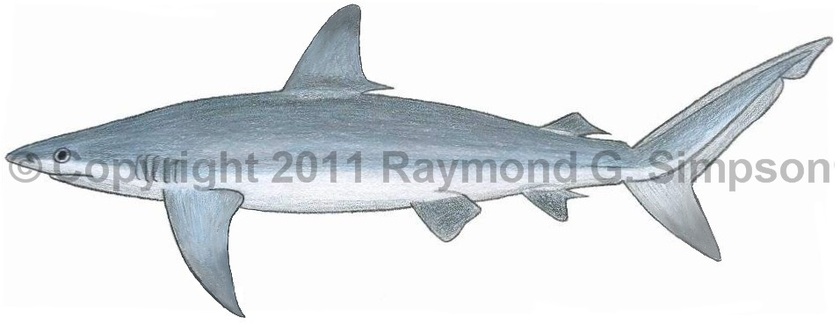
Common Name
Dusky Shark
Year Described
Lesueur, 1818
Identification
Anteroposterior tooth rows: 14-15/13-15 on each side; 29-33/29-33 total
Vertebrae: 86-97 precaudal, 173-194 total
A large and slender/stout shark with a short and rounded snout. Eye small. Distance between nostrils 1.0-1.4 times in pre-oral distance. Nasal flaps rudimentary. Upper labial furrows short. Interdorsal ridge is present. Long preanal ridge absent. No keels on caudal peduncle. Gill slits short (2.7-4.0% TL). Teeth in upper jaws broadly traingular and serrated, with a thick oblique to erect cusp. Lower jaw teeth broad-based and serrated, with narrow, erect cusps. First dorsal fin fairly low (6.0-9.1% TL) with a strongly convex anterior margin, a rounded to pointed tip, and inserted over or just posterior to free tip of pectoral fin. Second dorsal fin much smaller (1.8-2.3% TL) and inserted almost directly above anal fin. Both dorsal fins with extended free posterior tips (second dorsal free tip about twice height of second dorsal). Anal fin similar in size to second dorsal fin. Pelvic fin origin well behind free tip of first dorsal. Pectoral fin long and highly falcate, with a sharply pointed tip.
Color
Gray to bluish-gray above, abruptly white below. Fins unmarked in adults. Lower fins dusky-tipped in juveniles.
Size
Mature adults from 257-300cm TL. Newborns from 69-100cm. Maximum size to around 400cm TL.
Habitat
Widespread on continental shelf from 1-400m, on the bottom or in open waters. Juveniles inshore and in estuaries but not in low salinity areas.
Range
Continental from Canada to the Bahamas and N. Cuba, the Gulf of Mexico, and the coast of Central America to Panama. Also from Trinidad to S. Brazil. Rare or absent in the eastern and southern Caribbean Sea.
References
Castro, J.I. 2011. The Sharks of North America. Oxford University Press, 640 pp.
Compagno, L.J.V. 2002. Sharks. In: Carpenter, K.E. (Editor) FAO Identification Guide for Fishery Purposes. The Living Marine Resources of The Western Central Atlantic. Volume 1: Introduction, mollusks, crustaceans, hagfishes, sharks, batoid fishes, and chimaeras. ASIH Special Publication No. 5. FAO, Rome.
Compagno, L., M. Dando, and S. Fowler. 2005. Sharks of the World. Princeton University Press, 480 pp.